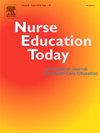Investigation of the relationship between medical artificial intelligence readiness and individual innovativeness levels in nursing students
IF 3.6
2区 医学
Q1 EDUCATION, SCIENTIFIC DISCIPLINES
引用次数: 0
Abstract
Aim
This study was conducted to identify nursing students' medical artificial intelligence readiness and individual innovativeness levels, to examine the relationship between these two concepts and to determine the variables that create a significant difference.
Methods
A descriptive and correlational design was employed. The sample of the study consisted of undergraduate nursing students from two different universities in Istanbul province, both of which focus on similar educational goals (n = 386). Data were collected between March and May 2024 using a questionnaire involving a “Student Information Form,” the “Medical Artificial Intelligence Readiness Scale,” and the “Individual Innovativeness Scale.” Descriptive statistical methods, t-test, ANOVA, and Pearson correlation test were used to analyze the data.
Results
The mean age of the students was 21.78 ± 1.84 years (18–35), 78.8 % were female, and 35.5 % were 2nd- and 3rd-year students. The students' mean score was 69.36 ± 12.92 on the total Medical Artificial Intelligence Readiness Scale and 52.92 ± 7.37 on the total Individual Innovativeness Scale. In addition, gender, family structure, income status, choosing the nursing department willingly, following scientific/technological developments in the field, having received training in artificial intelligence, having knowledge about the use of artificial intelligence in the health field and nursing, and having attended training/seminars on innovation were determined to be effective variables on Medical Artificial Intelligence Readiness and Individual Innovation. There was a significant positive relationship between the mean total and subscale scores on the Medical Artificial Intelligence Readiness Scale and the Individual Innovativeness Scale (p < 0.05).
Conclusion
Nursing students' medical artificial intelligence readiness levels were above average, and their individual innovativeness levels were low. It was found that as the students' medical artificial intelligence readiness levels increased, their individual innovativeness levels increased, as well. Although increased readiness levels boost the level of individual innovation, promising practices should be integrated into education for more advanced relationships and higher scores.
求助全文
约1分钟内获得全文
求助全文
来源期刊

Nurse Education Today
医学-护理
CiteScore
6.90
自引率
12.80%
发文量
349
审稿时长
58 days
期刊介绍:
Nurse Education Today is the leading international journal providing a forum for the publication of high quality original research, review and debate in the discussion of nursing, midwifery and interprofessional health care education, publishing papers which contribute to the advancement of educational theory and pedagogy that support the evidence-based practice for educationalists worldwide. The journal stimulates and values critical scholarly debate on issues that have strategic relevance for leaders of health care education.
The journal publishes the highest quality scholarly contributions reflecting the diversity of people, health and education systems worldwide, by publishing research that employs rigorous methodology as well as by publishing papers that highlight the theoretical underpinnings of education and systems globally. The journal will publish papers that show depth, rigour, originality and high standards of presentation, in particular, work that is original, analytical and constructively critical of both previous work and current initiatives.
Authors are invited to submit original research, systematic and scholarly reviews, and critical papers which will stimulate debate on research, policy, theory or philosophy of nursing and related health care education, and which will meet and develop the journal''s high academic and ethical standards.
 求助内容:
求助内容: 应助结果提醒方式:
应助结果提醒方式:


